All about sunglasses
Part 2: Choosing the shape of the frame
Choosing sunglasses involves much more than picking a frame or style design. The choice of sunglasses should be based on two things: fashion appeal and usefulness. Informed consumers should read the descriptions found on labels carefully.
Scientists forecast that ultra-violet rays will grow stronger in the future. To prevent sight deterioration, the American Optometric Association, the American Academy of Ophthalmology, as well as the National Society all recommend increasing protection standards for all sunglasses so that they block at least 99% of UVB rays and 60% of UVA rays. Sunglasses are now rated under three categories - cosmetic needs, general needs and special needs - with each category having different protection requirements.
The confusion over protection levels will likely persist until a standard rating system is implemented.
Dr Jack Weber, Director of the Research and Education Department at Marchon Eyewear, has identified a number of consumer perceptions when it comes to choosing sunglasses.
The most commonly-held belief on the subject is that the darker the lenses, the better the protection they afford. This, however, only affects your eyes' comfort, not their protection. The important thing is the level of protection against UV rays, not comfort! It is possible to get a high degree of UV protection even from lightly tinted lenses. You should carefully read all instructions given on the label to find out what level of protection these particular sunglasses provide.
The second commonly held belief is that if you can still see the eyes through the lenses, the lenses are not dark enough. In fact, dark or light, no lenses will protect your eyes from UV rays unless they have been specially treated for that purpose. Dark sunglasses which have not been treated to prodive UV protection are dangerous, says Dr. Weber, because these glasses allow the pupil to dilate, thus exposing your eyes to more of the damaging UV rays.
Whether light- or dark-colored, all eyes need the same level of protection, says Dr Weber. Your sunglasses must provide 99% protection against UV rays. For comfort, light-colored eyes will feel better with darker lenses, while darker-colored eyes can better tolerate lighter lenses. Given that UVA and UVB rays are present even under cloudy conditions, Dr Weber recommends you wear sunglasses anytime you go out. Fendi and Calvin Klein sunwear adhere to these principles and conform to maximum recommended specifications.
Better knowledge for better choice
There has been growing public concern these past few years over problems related to the depletion of the ozone layer. While the ozone layer could be depended upon to protect us from UV rays by absorbing the most harmful rays and preventing them from reaching the earth, the thinning ozone layer today provides diminished protection, thus increasing the risks from exposition to the sun. While everyone knows that you should not expose your skin to the sun without first protecting it, few remember to protect their eyes!
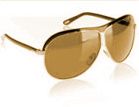
Brown Lenses
- Efficient against glare
- Protects against UV
- Changes color perception but enhance contrasts and give more definition to objects
- Much used for driving glasses or for sports requiring a degree of precision (for example tennis, golf, etc.)
We hear more and more about ultraviolet (UV) rays. Nevertheless, very few people really know what those rays really are. In fact, it is quite simple: UV rays are invisible light waves, which carry more energy than visible light. There are three types of rays:
UVCs
Absorbed by the ozone layer, few reach the earth.
UVBs
These hot sun rays are responsible for snow blindness and can cause cataracts to form.
UVAs
Potentially harmful. We should protect ourselves by wearing quality sunglasses. When we are directly exposed to the sun, without any protection, UV rays can be harmful to our eyes. In the same way they burn our skin, UVs can irritate and even burn the cornea. Prolonged exposition can also damage contact lenses. Premature development of cataracts and failing sight that could eventually lead to blindness figure among the risks of long-term exposition.
We each have our own reasons for wearing sunglasses, but the main reason is still to eliminate the glare from blinding light. When too much light penetrates the pupil, as happens on a bright and sunny day, we squint against the sun and our pupils contract to protect themselves. But these natural defenses are insufficient to protect us from prolonged exposition to intense brightness, which could cause the following symptoms to appear:
- Headaches;
- Itching around eyelids;
- Uneasiness around brow bones;
- Loss of contrast due to glare.
This is when a good pair of sunglasses becomes indispensable.
But what makes a good pair of sunglasses?
Here are the main points to look for when choosing a good pair of sunglasses:
TINTS In choosing sunglasses, the right tint will depend on the intended use as well as on personal taste and needs. While there are endless possibilities to choose from, you should select a color that is intense enough to protect efficiently. Here are the main characteristics of the most common colors and the recommendations of specialists:
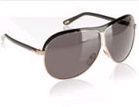
Gray Lenses
- Good UV and infrared protection
- Will not alter colors
- Good for general use
- Very soothing to the eyes

Green Lenses
- Good UV and infrared protection
- High performance against glare
- Only slight color alteration
- Good color for general use
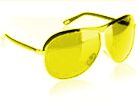
Yellow Lenses
Not a sunwear color on a daily use. On the contrary, these lenses are designed to be worn in foggy or cloudy weather because they accentuate contrasts and details. They are specially designed for hunting, skiing, sailing and boating, in short for any sport requiring very good visual acuity.
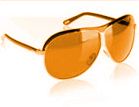
Orange Lenses
Roughly the same properties as yellow lenses.
Mirror lenses
The mirror effect is obtained by coating plastic or glass lenses with a layer of nickel and chrome alloy.
Gray - or green- tinted mirror lenses
They provide maximum protection against UV and infrared rays.
Transmission is low since these lenses reflect light.
Mirror lenses are ideal if you are to be exposed to intense bright light from sun, snow or water reflection (mountain climbing, glacier climbing, skiing, snowmobiling, windsurfing, etc.)

Other Tints (Blue, Pink, Purple, etc.)
These tints are not, as such, sunwear tints but are used for their cosmetic appeal. They are available in a wealth of colors.
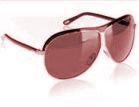
Tints fall under two broad categories
Through tint
The lens is tinted through and through. This type of tint is more durable and better resists fading over time. In addition, a scratch on the lens will be less visible since color permeates the lens and cannot be scratched off.
Surface Tint
This tint is obtained by soaking, the color remaining on the surface of the lens only. Much less costly to start with, this tint will however fade over time and scratches will be much more visible since only the surface of the lens is colored.
Methods used to manufacture lenses vary but there are two main methods.
Polished lenses
These lenses are polished using specialized machinery, so they are optically perfect, with no imperfection or distortion.
Hot-pressed or moulded lenses
While much less costly than polished lenses, this technique may produce irregularities and aberrations in the lens, which can distort the perception of objects, forcing the eye to adjust constantly in order to focus. This leads to eye fatigue, which, after some time, can cause headaches.
Frame materials
A wide variety of materials and alloys can be used. It would take too long to explain each one's properties, but here are the essential qualities of a premium frame:
It must be flexible so that it can be properly adjusted.
It must be able to absorb shocks.
It must be both light and strong.
Lens Materials
Characteristics of plastic lenses vs glass lenses
Plastic lenses
- light
- safe
- Scratch easily
Glass lenses
- more heavy
- Could easily shatter if unprotected or not tempered
- Very resistant to scratching
Anti-Reflection Treatment
This treatment is used to eliminate undesirable reflections. It can be applied on glass or plastic lenses and is usually applied to the inside surface of high-end sunglasses. The advantage of such a treatment is that it eliminates reflection, providing excellent visual comfort.
Photo : Mickael Kors Collection available at IRIS boutiques



| Spas | Care & Make-up | Health | For Men | Glossaries | Various | |||||
| Intro | Face (care) Make-up Body Hair Endless Youth Mother & Baby Corner Suncare Essentials And more... New products Spot A HairdresserMake-up Artist Directory | Healthy Diet Watching your figure Relaxation | Intro New products | All about... | Phytotherapy All Natural Fashion Perfume Jewelry & accessories And more... What is your style? |
-

 Spas
Spas
-

 Care & Make-up
Care & Make-up
-

 Health
Health
-

 For Men
For Men
-

 Glossaries
Glossaries
-

 Various
Various








